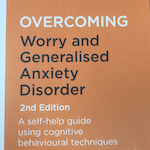Separation anxiety (adult)
What is it?
Separation anxiety disorder is defined as excessive anxiety, fear or avoidance behaviour upon separation from attachment figures. Until recently, to make the diagnosis of Separation Anxiety Disorder in an adult, clinicians had to establish that the characteristic symptoms first emerged during childhood or adolescence. We now know that the ‘adult-onset’ condition is quite common. It causes much distress, has an adverse impact on everyday functioning, and often occurs with other conditions, such as depression. Adult-onset Separation Anxiety Disorder has some features like those of other anxiety disorders, especially Panic disorder and Generalised Anxiety Disorder (GAD), and it can be a challenge to distinguish between these conditions. A large proportion of clients with anxiety disorders have symptoms which can be traced back to childhood experiences and environments but manifest as clinical symptoms during adulthood: and separation anxiety disorder is considered in the same way as these other conditions. Adult separation anxiety disorder refers to individuals whose symptoms started in adulthood, without documented evidence of related symptoms during childhood, as well as individuals who had a childhood onset and in whom symptoms persist into adulthood. Adults with prominent separation anxiety frequently experience strong fears that their attachment figure (usually a spouse or child) will come to harm and make attempts to remain in close contact with them despite troublesome impracticalities.
DIY self diagnosis
Symptoms of Separation Anxiety Disorder
Separation Anxiety Disorder in adults is characterised by excessive fear or anxiety around actual or possible separation from someone they are attached to (the ‘attachment figure’) such as a partner and/or children.- There may be fears they may be exposed to harmful events, a reluctance or refusal to go to work due to these fears.
- Excessive distress when the person living with separation anxiety is separated from the attachment figure.
- To be clinically diagnosed, fear, anxiety, or avoidance of separation, must typically be present for at least six months.
- Diagnosis also requires at least three of eight features to be present, including recurrent excessive distress when anticipating or experiencing separation, and persistent, excessive worry about losing major attachment figures.
Separation anxiety (adult)
 |
Separation anxiety (adult)This fact sheet gives a detailed overview, as well as a look at some of the evidence based approaches to managing anxiety among children. |
Download Free |
Recommended resources

Overcoming Worry and Generalised Anxiety Disorder (2nd Ed) by Mark Freeston and Kevin Meares – Written by two of the UK’s leading experts on generalised anxiety, Overcoming Worry uses cognitive behavioural therapy methods to help change the self-defeating ways we think, in order to feel better. This positive, pragmatic approach is popular with therapists and patients alike. You can purchase your copy from the Anxiety UK shop here.






